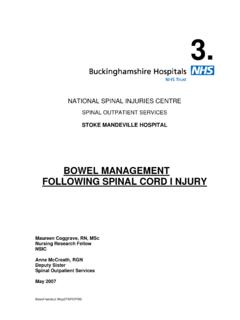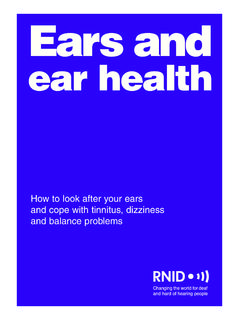Transcription of Patulous Eustachian tube - buckshealthcare.nhs.uk
1 How can I help reduce healthcare associated infections? Infection control is important to the well-being of our patients and for that reason we have infection control procedures in place. Keeping your hands clean is an effective way of preventing the spread of infections. We ask that you, and anyone visiting you, use the hand sanitiser available at the entrance to every ward before coming in to or after leaving the ward. In some situations hands may need to be washed at the sink using soap and water rather than using the hand sanitiser. Staff will let you know if this is the case. Author: Issue date: Review date: Leaflet code: Version: Mr I Bottrill November 2016 November 2018 PET-001 Patulous Eustachian tube Follow us on Twitter @buckshealthcare Patient information leaflet If you require a translation or an alternative format of this leaflet please call Patient Advice & Liaison Service on 01296 316042 Patulous Eustachian tube Patulous comes from the word patent or open.
2 The Eustachian tube is normally closed in the resting position and prevents air and fluid as well as sound from passing from the back of the nose and throat up into the ear. The Eustachian tube is supposed to open to regulate air pressure inside the middle ear and typically does this during a strong swallow or a yawn. When Patulous , the Eustachian tube becomes stuck in the open position and causes voice and breathing noises from the nose and throat to travel up the tube and be heard loudly in the ear. It can also cause a sensation of pressure changes in the ear with breathing. It is often difficult for doctors and even specialists to make an accurate diagnosis of this condition.
3 Most patients with a Patulous Eustachian tube experience a symptom called autophony. This refers to hearing your own internal noises amplified excessively. The most disturbing and loudest sounds are usually your own voice and nasal breathing and it sounds as if you are talking and breathing into a wind tunnel or echo chamber. The symptoms can usually be at least temporarily relieved by sniffing in or by lying down or placing your head down between your knees. This causes some temporary tissue swelling in the head and Eustachian tube that can force the tube to close. Some patients can gently sniff inward and get lasting relief of symptoms as the vacuum can at least temporarily close the Eustachian tube.
4 However, excessive sniffing can cause negative pressure within the middle ear that can lead to a sucked-in eardrum and fluid in the middle ear. This creates confusion as patients and doctors will be led to believe that the Eustachian tube is blocked ( Eustachian tube dilatory dysfunction), causing glue ear. It is a day surgical procedure and does not require an overnight stay in the hospital. If patients wish to fly home after the procedure we place a grommet in the eardrum during the operation so they can comfortably fly home and the grommet will fall out within a few months. The Eustachian tube would be blocked due to the swelling of the surgery on a temporary basis making it uncomfortable to fly without a ventilating grommet.
5 Risks of surgery Although the surgery is a relatively simply procedure, there are potential complications: on the day of surgery usually very mild and stop without any further treatment. damage from the instrument used to hold the mouth open during the operation. to stop the autophony requiring a top up procedure build up behind the ear drum which may clear on its own, but if it doesn t, a grommet can be placed in the drum. feeling of pressure in the head which usually clears after surgery but occasionally can be permanent. Please contact the ENT office if there are any additional questions and we will be happy to help.
6 2 7 Patulous Eustachian Tube reconstruction (PETR) with grafts or implants Reconstruction of the Patulous defect can be accomplished by removing most of the lining of the Eustachian tube to make a raw surface inside the tube. The intention is to narrow the tube down without completely blocking it. Most commonly, fat implant is packed into the raw channel of the Eustachian tube and the opening is closed with sutures. This procedure temporarily causes complete blockage of the channel and necessitates placing a grommet into the eardrum, which will stay in place until there is evidence that the Eustachian tube is functioning again, usually after a few months.
7 Obliteration of the Eustachian tube will relieve the Patulous Eustachian tubes usually on a permanent basis. A grommet in the eardrum will usually be required permanently to prevent ear blockage, deafness due to fluid build-up in the ear, and other complications. Grommets can sometimes become blocked with mucus, so obliteration is not a first choice. It would be reasonable to offer a surgical repair if you have failed medical efforts for treatment of your Patulous Eustachian tube condition and your Otolaryngologist (ear specialist) is certain you have a Patulous Eustachian tube after seeing the eardrum move. Treatment is often directed to try to open up the Eustachian tube in such cases which is contrary to resolving the actual Patulous problem.
8 Another condition called Superior Semicircular Canal Dehiscence syndrome (SSCD) is an inner ear problem that can cause autophony similar to a Patulous Eustachian tube with amplification or echoing of a person's voice in their ear, but they usually do not have autophony of their nasal breathing. A doctor will have to differentiate between these two. The most conclusive method for diagnosing a Patulous Eustachian tube is for an ear doctor to actually see the eardrum moving in and outward while the patient does strong nasal breathing through the same side as their symptoms and holding the opposite nostril closed. This usually needs to be done while sitting up.
9 The pressure changes will go right up the Eustachian tube and move the eardrum and the doctor can see this. This examination should be done while the autophony symptoms are present. If the patient cannot make the symptoms active during the clinic visit then some brief exercise such as deep knee bends, running up and down some stairs, or jogging around the block can usually recreate symptoms as adrenaline levels will shrink the Eustachian tube to a more open position. 6 3 Medical treatment There are some useful medical treatments for Patulous Eustachian tubes . Increasing fluid intake generally, nasal saline drops or rinses/irrigations can be very helpful in wetting the mucous membrane of the Eustachian tube that becomes dried out.
10 For a more potent irritation effect that can stimulate more swelling of the mucous membrane and more secretions, extra strength nasal drops can be made by mixing four teaspoons of table salt into a cup of water. Some irritants have been found to effectively swell the Eustachian tube to a closed position. A commonly used weak acidic solution can be purchased on the internet without prescription ( PatulEND ). Patients find it of varying benefit, but the irritation usually improves within the first few days. If there is evidence of any beneficial effect within the first two weeks it can be continued for two months to try to gain a lasting benefit.






